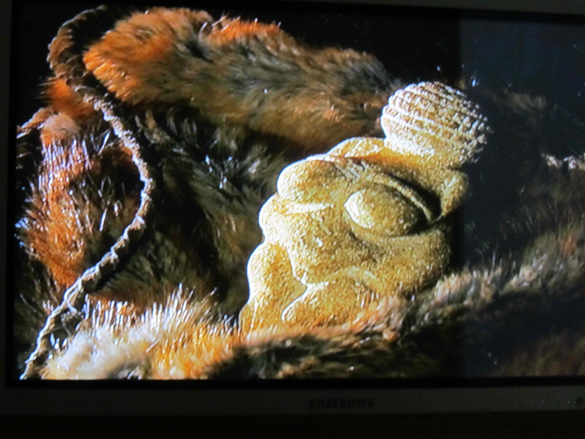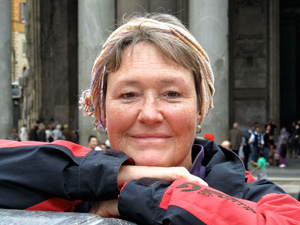 Prehistoric Venus Figurine. Photo by Sherry Hardage
Prehistoric Venus Figurine. Photo by Sherry Hardage  Reconstructed woman’s face from skull found in the L’Abri du Cap Blanc burial. Photo by Sherry Hardage
Reconstructed woman’s face from skull found in the L’Abri du Cap Blanc burial. Photo by Sherry Hardage  Solo Traveler: Prehistoric Man, Part I
Solo Traveler: Prehistoric Man, Part IIn Paris there is a famous museum, dedicated to all that is human, called Museé du Quai Branly. It has a collection of art and useful objects from around the globe, created by humans since the dawn of our species.
On a recent trip to France, there was simply too much else to see. That museum will be one of many enticements to lure me back. What my friend Joyce and I experienced, instead, were the decorated caves of the Vézére Valley, in southwestern France.
It is a region with a thick limestone cap over sedimentary rock, carved into striking white cliffs by the river. Contained within that area is evidence of human occupation for over 400,000 years. Neanderthals occupied much of Europe during several ice-ages. They hunted the reindeer, bison, horse, bovine, wooly rhino and mammoth. They were smart, adaptable, and survived for a very long time until modern humans arrived from Africa.
Then, over a short 10,000 years, they disappeared. There is much speculation as to whether they were killed off, died out, or were genetically absorbed by their technically advanced cousins.
The National Museum of Prehistory in Les Eyzies-de-Tayac-Sireuil is geared toward giving the visitor an overview of prehistoric life in the valley. In addition to numerous display cases of arrowheads, flint knives, and animal bones (with evidence of butchering,) there are a number of small alcoves, each with a movie showing how objects were made.
One shows an antler modified to become a spear point, and another demonstrates how to knap flint into an arrowhead or axe. The most interesting film documented the making of a prehistoric Venus, starting out with a medium sized limestone rock from a riverbed. It was a surprising how the fragile flint tools could scrape away, cut through, and mark up the limestone with relative ease.
It was a great film to watch before going into the caves and overhangs to see the actual carvings created 10,000 to 17,000 years ago. Even in the relative slack of late fall, the limited tours of the caves fill up. We were able to get tickets to L’Abri du Cap Blanc, a sculpted overhang in the Beune Valley. We returned the next day to see Campanelles, a snaky little cave with engravings.
Cap Blanc was about three miles from Les Eyzies, up a curving road that followed the river. Along the way, we could see the white limestone cliffs, house ruins from Neolithic and Medieval times, and overhangs created when the river undercut the cliffs.
At Cap Blanc, the soft underbelly of the cliff face was occupied around 12,000 years ago. There are holes carved in a U-shape that were used to attach large skins. The heat from a fire would be reflected by the rock wall and keep the occupants of the lean-to-tent quite warm.
On the back wall of the overhang is a sculpted relief, thought to be the work of one man who may have carved the entire scene in less than three months. The artistic style is consistent and the revealed scene is a composition with a large horse in the center, mirrored on either side by groups of horses and bison. Buried directly beneath the central horse are the remains of a woman, between 25 and 35 years old. (The bones at the site are replicas. The actual skeleton is in the Field Museum in Chicago.)
Our French guide couldn’t hide his romantic nature. He proposed the frieze was a monument to the woman, possibly carved as a way to relieve the intense grief caused by her passing. Of course there’s no way to know for certain, but the relationship of a single female burial in the center under the horse, and the obvious composition of the animals certainly give credence to that theory.
A forensic artist in Paris obtained the woman’s skull from the Field Museum, and recreated her face. The model in the museum shows a woman with wide high cheekbones and a complexion common among Northern Europeans today.
For much more information on Cap Blanc and the woman’s remains, click on this link: CapBlanc
Editor’s note: Sherry Hardage lives in Los Alamos and has been traveling solo in the Americas, Europe, and Asia since she retired from Honeywell in 2009. She is a photographer, writer and guide who organizes tours of Chiapas, Mexico through her website www.mexadventures.com
Follow her continuing adventures on the travel blog http://sherryhardagetravel.blogspot.com/
Hardage welcomes comments at hardagesa@aol.com

